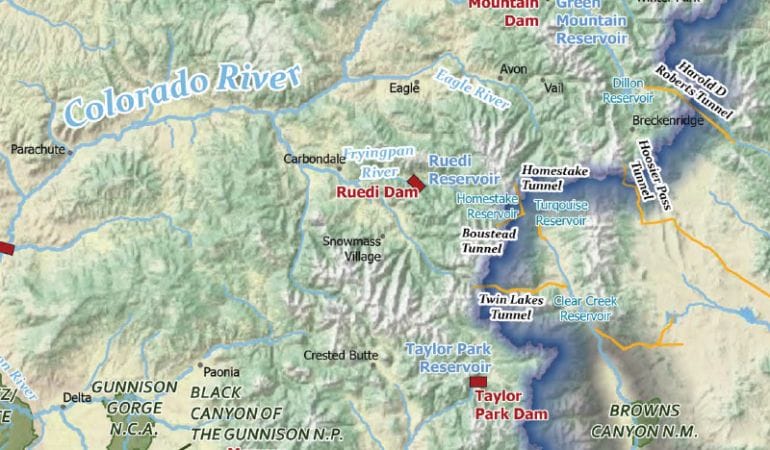
A Cartographic Meditation
The Babbitt Center’s new Colorado River Basin map is available at no cost as a downloadable pdf and as a hard copy.
Where is the Colorado River Basin? A novice attempting a cursory Google search will be surprised—and perhaps frustrated, confused, or a little of both—to find that there is no simple answer to that question. Winding through seven U.S. states and two states in Mexico—and supporting over 40 million people and 4.5 million acres of agriculture along the way—the Colorado River is one of our most geographically, historically, politically, and culturally complex waterways. As a result, creating an accurate map of the basin—the vast area of land drained by the river and its tributaries—is not a simple undertaking.
Commonly used maps of the region vary widely, even on basic details like the boundaries of the basin, and most haven’t kept up with changing realities—like the fact that the overtapped waterway no longer reaches its outlet at the sea. At the Babbitt Center, we began to hear a common refrain as we worked on water and planning integration efforts with stakeholders throughout the West: people frequently pointed out the flaws in available maps and suggested that addressing them could contribute to more effective water management decisions, but no one seemed to have the capacity to fix them. So, with the help of the Lincoln Institute’s newly established Center for Geospatial Solutions, we embarked on a mapping project of our own.
Our newly published peer-reviewed Colorado River Basin map seeks to correct several common errors in popular maps while providing an updated resource for water managers, tribal leaders, and others confronting critical issues related to growth, resource management, climate change, and sustainability. It is a physical and political map of the entire Colorado River Basin, including the location of the 30 federally recognized tribal nations; dams, reservoirs, transbasin diversions, and canals; federal protected areas; and natural waterways with indications of year-round or intermittent streamflow. We are making the map freely available with the hope that it will become a widely used resource, both within the basin and beyond.
Challenges, Choices, and Rationale
Even though they have few words, maps still speak. All maps are somewhat subjective, and they influence how people perceive and think about places and phenomena. During the peer review process for our new map, one reviewer asked whether our purpose was to show the “natural” basin or the modern, aka engineered and legally defined, basin. This seemingly simple question raised several fundamental questions about what a “natural” basin actually is or would be. This struck us as akin to a perennial question facing ecological restoration advocates: to what past condition should one try to restore a landscape?
In the case of the Colorado, this question becomes: when was the basin “natural”? Before the construction of Hoover Dam in the 1930s? Before Laguna Dam, the first dam built by the U.S. government, went up in 1905? The 18th century? 500 years ago? A million years ago? In an era when the human–natural binary has evolved into a more enlightened understanding of socioecological systems, these questions are difficult to answer.
We struggled with this quandary for some time. On the one hand, representing a prehuman “natural” basin is practically impossible. On the other hand, we felt an impulse to represent more of the pre-dam aspects of the basin than we typically see in conventional maps, which often privilege the boundary based on governmental contrivances of the 19th and 20th centuries.
Ultimately, after multiple internal and external review sessions, we agreed on a representation that does not attempt to resolve the “natural” versus “human” tension. We included infrastructure, clearly showing the highly engineered nature of the modern basin. We also included the Salton Basin and Laguna Salada Basin, two topographical depressions that were formed by the Colorado. Both are separate from the river’s modern engineered course, and often excluded from maps of the basin. We didn’t choose to show them because we expect the Colorado River to jump its channel any time soon, nor because we presume to accurately represent how the delta looked prior to the 20th century. But from our research, we learned that the 1980s El Niño was of such magnitude that river water from the flooded lower delta reached back up into the dry bed of the Laguna Salada, making commercial fishing possible there. Environmental management of the heavily polluted Salton Sea, meanwhile, is a contested issue that has figured in recent discussions about future management of the Colorado. These areas are not hydrologically or politically irrelevant.
Our map doesn’t attempt to answer every question about the basin. In many ways, our contribution to Colorado River cartography highlights the unresolved tensions that define this river system and will continue to drive the discourse around water management and conservation in the Colorado Basin.
There is no simple definition of the Colorado River Basin. That might be the most important underlying message of this new map.
Zachary Sugg is a senior program manager at the Babbitt Center for Land and Water Policy.
Related Content

